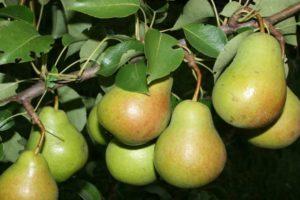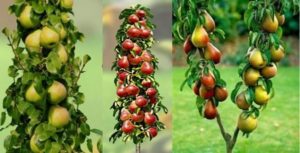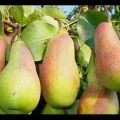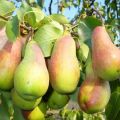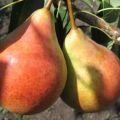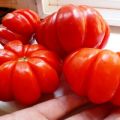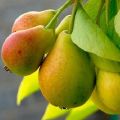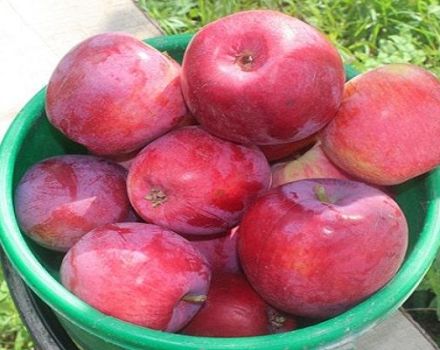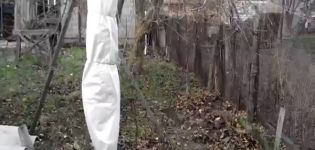Description and characteristics of the pear variety Forest beauty, planting and care
The forest beauty pear has been grown for more than one century. The first seedlings were discovered in a Belgian forest in 1810. The autumn variety is frost-resistant, bears fruit abundantly, its genetic properties are used to obtain new promising forms. In Russia, the forest beauty can be found in amateur gardens of the Lower Volga region, the Urals, the Trans-Urals, Siberia.
Description and characteristics of the variety
Dessert variety, fruits are not large, ovoid. Only single specimens weigh 250-300 g. The mass of most of the fruits does not exceed 120-150 g. They are covered with a rough, strong skin - first green-yellow, then golden-yellow. Ripe pears are colored with a bright blush. Brown spots and gray dots on the skin are a varietal feature. The fruiting period depends on the climatic zone. It falls in the second half of August - the first half of September.
The taste of the juicy fruits of the Forest Beauty is wine-sweet. They do not lie for a long time, so they are used as raw materials for homemade preparations. Delicious preserves and jams are made from aromatic pears, compotes are rolled up and dried.
Pollinating varieties
It makes no sense to plant one Forest Beauty pear in the garden. Without external pollinators, the yield will be small. For this purpose, varieties are suitable:
- Lemon;
- Williams;
- Mechelnskaya.
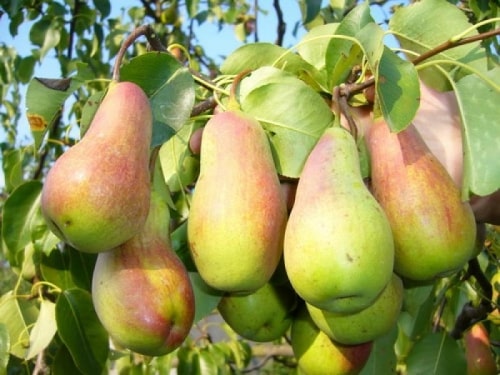
Tree height
Medium-sized tree species. By the end of the 10th year of life, the pear reaches 5 meters in height. The crown is wide, pyramidal. It is formed by straight, thick, slightly curved dark red branches. The leafy crown is medium. The edge of the leaves is serrated (finely cribbed, finely serrated).
Life span
Trees of the Forest Beauty variety are distinguished by their great vitality. The variety is old, therefore, specimens of pears have been recorded that have survived to 100-150 years.
Winter hardiness
The variety is winter-hardy, tolerates short-term drops in temperature to -50 ° C. The minimum threshold is for mature fruit trees. The aboveground part of young pears may freeze slightly.
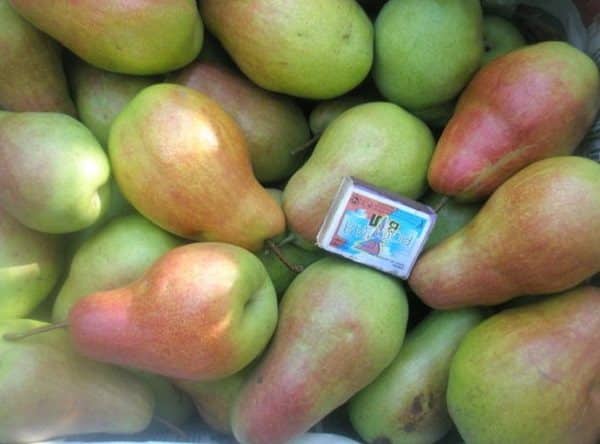
Yield
The variety is productive, from one tree fruits from 100 to 200 kg are removed. The volume is influenced by the weather. Productivity decreases in hot, dry years, increases if summer is moderately warm and humid.
Cyclic fruiting The forest beauty blooms and bears fruit every year.
Self-fertility
For the Forest Beauty variety, partial self-fertility is characteristic.In order to get stable yields, pears are planted in the garden by pollinators, which bloom at the same time.
Disease resistance
Fruits and leaves suffer from scab. Variety Forest Beauty is not resistant to Venturia pirina fungus.
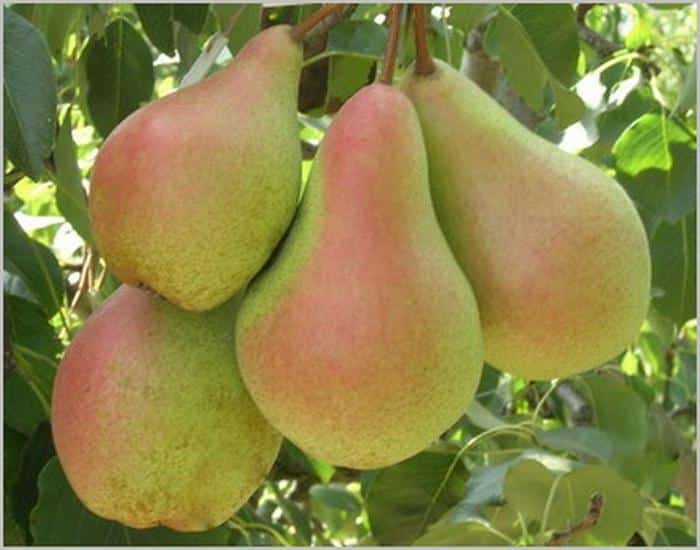
Advantages and disadvantages
The forest beauty pear fell in love with gardeners for its yield, tasty fruits, unpretentiousness, quick adaptation to weather conditions, non-exactingness to the composition of the soil, consistently high yield.
The variety has disadvantages. They must be taken into account before purchasing a Forest Beauty seedling:
- short storage period of the crop;
- shedding of fruits;
- susceptibility to the scab pathogen.
How to grow a Forest Beauty?
There are no problems with growing. The result when planting a healthy seedling is always positive. Gardeners choose the Forest Beauty variety for a reason. With proper planting and proper care, the fruit tree bears fruit for at least 50 years.
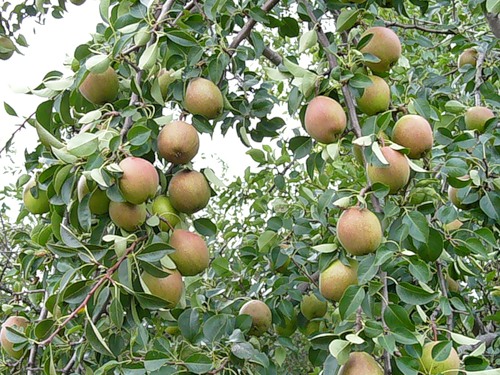
When is the best time to plant a pear?
Saplings of this variety take root better during spring planting. Suitable time for it is from April 10-15 to May 10. In regions with long, warm autumn, the Forest Beauty is planted in October.
Choosing a site for planting and preparing the soil
Well-lit areas behind the wind are suitable. The close occurrence of groundwater is undesirable. The tree will not fully develop. The soil should be light, conductive to water and air.
The soil for filling the planting pit is prepared as follows:
- fertile garden soil is mixed in equal proportions with humus, sand is added to clay;
- apply long-acting fertilizers (superphosphate 250 g, potassium sulfate 120 g) to the soil mixture.
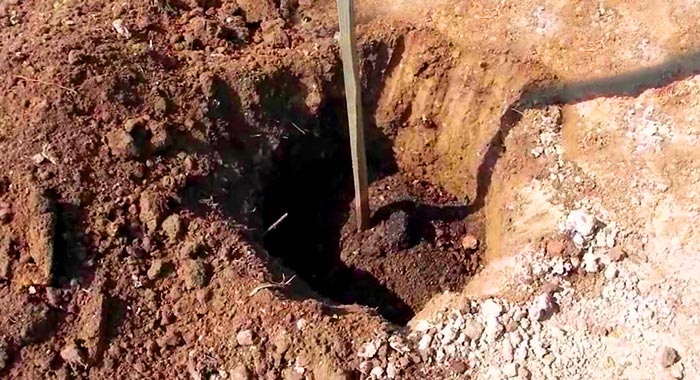
Sapling planting process
The pit is dug a week before the planned landing. Its dimensions: width - 0.7 m, depth - 1 m. The seedling needs support for the first time. A stake of 1.5-2 m high is driven into the center of the prepared pit. A mound of fertile soil mixture is poured around it. The seedling is placed on the south side of the support, the roots are covered without deepening the root collar. As a result, it should be 5-7 cm above the ground. The pear is watered abundantly. The trunk circle is mulched with humus.
When landing, adhere to the following schemes:
- saplings on tall grafts are planted at 4 x 6 m intervals;
- dwarf scion trees - 3 x 5 m.

Wood care measures
Activities for the care of the Forest Beauty are reduced to watering, feeding, working with the crown. Supports are placed under the branches during the fruiting period. Despite their strength, they can break under the weight of the crop.
How to water properly?
The annual Forest Beauty pear is watered once a week. She needs 10 liters of water. As it grows, the flow rate increases. For 1 m² of water crowns, 2 buckets are already consumed. The frequency of procedures is reduced to 1 time in 10 days.
Adult fruit trees are watered three times:
- before blooming buds;
- during the discharge of an extra ovary;
- when pouring fruits.

In August, pear irrigation is not required. The last watering of the season (water-charging) is carried out in October. It requires a lot of water. For 1 adult pear, about 80 liters are spent.
Feeding rates
Up to 3 years, the pear receives nutrients from the soil mixture laid in the pit during planting. A matured fruit tree is fed with organic matter and mineral fertilizers:
- every year if the soil is sandy;
- in a year, if the soil is black earth or loam.
| Application time | Fertilizer | Rate per m² |
| Spring (March to April) | Manure | Mulch the trunk circle |
| Slurry (1:10) | 1 bucket | |
| Autumn after leaf fall | Ash | 650 g |
| Urea | 15 g | |
| Superphosphate | 50 g | |
| Potassium nitrate | 20 g |
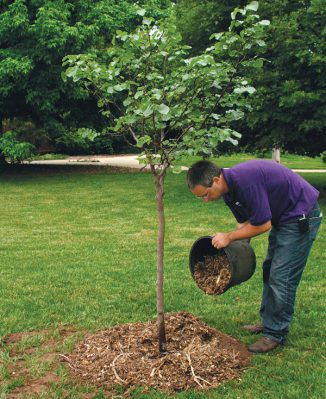
The subtleties of crown molding
The first tier of the crown is laid in the first year. 3 skeletal branches are left. Shorten them by ⅓ of the length. The crown of the central conductor is cut off by 15-20 cm.In the 2nd year, they are engaged in the formation of the 1st tier.Lateral shoots are shortened.
The next 2 years form the 3rd and 4th tier of the crown. In the future, they annually engage in sanitary pruning, rejuvenation is carried out when the yield falls, the growth of new shoots stops.
Preparing for winter
The first 2-3 years a young tree is insulated for the winter. The stem is covered with spruce branches, straw or wrapped with lutrasil. The insulation layer is fixed with a twine.
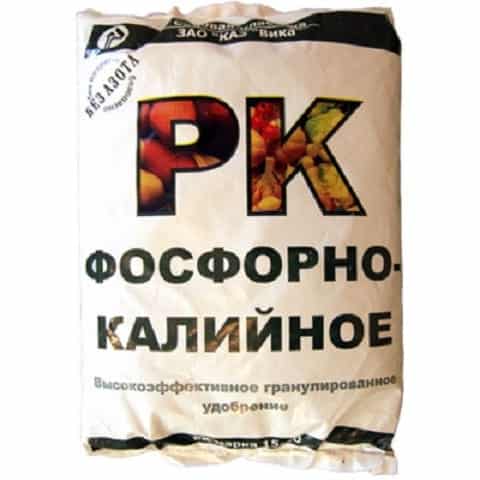
Preparation for wintering of adult plants is standard:
- autumn feeding with phosphorus-potassium fertilizers;
- protective watering on the eve of the first frost;
- mulching the trunk circle with a mixture of dry pine sawdust and humus.
During the summer, the leaves of the Forest Beauty are sprayed with ash infusion: 10 liters of water, 2 tbsp. sifted ash.
Disease and pest control
The main threat is scab, but other diseases (rust, powdery mildew) are not excluded. Damp weather (rain, cold dew, fog) is the cause of fungal diseases.
Timely preventive measures are the best remedy for infection.
List of preventive works:
- loosening the trunk circle;
- sanitary and formative pruning of the Forest Beauty crown;
- disposal of fallen leaves;
- chemical treatment.
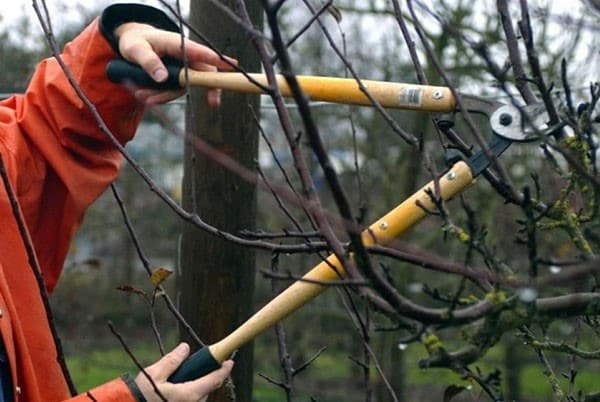
| Disease | A drug | Period |
| Scab | 0.5% copper oxychloride | When budding, at the end of flowering |
| 1% Bordeaux liquid | Fall | |
| Powdery mildew | 1% DNOC | Before bud break |
| 1% sulfur solution | When budding | |
| Rust | "Kuprosil" | Before flowering |
| After flowering | ||
| 2 weeks after harvest |
From insect pests (beetle flies, fruit mites) Forest beauty is treated with preparations:
- "Fufanon";
- Fitoverm;
- "Nissoran".
Harvesting and storage of crops
It is necessary to collect fruits green. When fully ripe, they fall off. You have to wait 6-7 years for the first harvest. Earlier for 2-3 years pears grafted on dwarf rootstocks of quince, irgi, mountain ash begin to bear fruit.
The crop is stored no more than 2, maximum 3 weeks... The term is given for rooms with a temperature of about 0 ° C. Pears must be stacked upside down, each layer must be shifted with paper. The variety has not lost its popularity for over 200 years. This he owes to his merits: unpretentiousness, frost resistance, good immunity, wonderful fruits. It is very convenient to have a long-lived tree in the garden.
